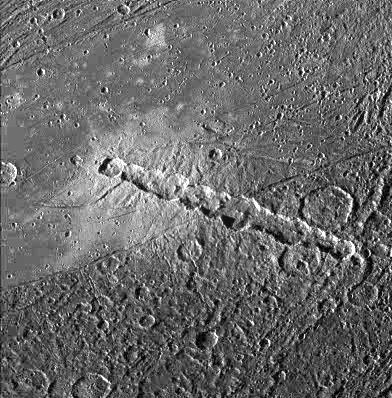Fitxategi:Chain of impact craters on Ganymede.jpg
Chain_of_impact_craters_on_Ganymede.jpg ((392 × 398 pixel, fitxategiaren tamaina: 51 KB, MIME mota: image/jpeg))
Fitxategiaren historia
Data/orduan klik egin fitxategiak orduan zuen itxura ikusteko.
| Data/Ordua | Iruditxoa | Neurriak | Erabiltzailea | Iruzkina | |
|---|---|---|---|---|---|
| oraingoa | 22:14, 21 uztaila 2006 |  | 392 × 398 (51 KB) | Peter439 | {{Information |Description=A chain of craters on Jupiter's moon Ganymede, probably caused by the impact of a fragmented comet. The picture covers an area about 120 miles wide. |Source= from http://antwrp.gsfc.nasa.gov/apod/ap011215.html |Date=1994 |Author |
Irudira dakarten loturak
Hurrengo orrialdeek dute fitxategi honetarako lotura:
Fitxategiaren erabilera orokorra
Hurrengo beste wikiek fitxategi hau darabilte:
- be.wikipedia.org proiektuan duen erabilera
- ca.wikipedia.org proiektuan duen erabilera
- cs.wikipedia.org proiektuan duen erabilera
- da.wikipedia.org proiektuan duen erabilera
- de.wikipedia.org proiektuan duen erabilera
- en.wikipedia.org proiektuan duen erabilera
- en.wikiversity.org proiektuan duen erabilera
- Draft:Original research/Radiation astronomy
- User:Marshallsumter/Keynote lectures (draft)/Meteor radiation astronomy
- Solar System, technical/Ganymede
- User:Marshallsumter/Rocks/Rocky objects/Ganymede
- Object astronomy
- Portal:Radiation astronomy/Lecture
- Portal:Radiation astronomy/Lecture/3
- Radiation/Astronomy
- User:Marshallsumter/Radiation astronomy/Craters
- es.wikipedia.org proiektuan duen erabilera
- fi.wikipedia.org proiektuan duen erabilera
- fr.wikipedia.org proiektuan duen erabilera
- fr.wikibooks.org proiektuan duen erabilera
- fr.wiktionary.org proiektuan duen erabilera
- gl.wikipedia.org proiektuan duen erabilera
- he.wikipedia.org proiektuan duen erabilera
- hr.wikipedia.org proiektuan duen erabilera
- it.wikipedia.org proiektuan duen erabilera
Ikus fitxategi honen erabilpen global gehiago.




